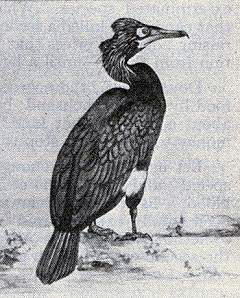- Spectacled Cormorant
Taxobox
name = Spectacled Cormorant
status = EX
extinct = c.1850
status_system = iucn3.1

image_width = 200px
regnum =Animal ia
phylum = Chordata
classis =Aves
ordo =Pelecaniformes
familia =Phalacrocoracidae
genus = "Phalacrocorax "
species = "P. perspicillatus"
binomial = "Phalacrocorax perspicillatus"
binomial_authority = Pallas, 1811
synonyms =
* "Graculus perspicillatus"
Taxobox_authority | author = Elliot | date = 1869
* "Pallasicarbo perspicillatus"
Taxobox_authority | author = Coues | date = 1869
* "Carbo perspicillatus"
Taxobox_authority | author = Rothschild | date = 1907
* "Compsohalieus perspicillatus"The Spectacled Cormorant or Pallas's Cormorant ("Phalacrocorax perspicillatus" ["Phalacrocorax",
Ancient Greek word for cormorants (literally "bald raven"). "perspicillatus",Latin for "conspicuous", in allusion of the birds' large size.] )is an extinct marinebird of thecormorant family ofseabird s that inhabitedBering Island and possibly other places in theKomandorski Islands . A presumed prehistoric record fromAmchitka Island ,Alaska (Siegel-Causey "et al.", 1991), is based on misidentification ofDouble-crested Cormorant remains (Olson, 2005).The species was first identified by
Georg Steller in 1741 onVitus Bering 's disastrous secondKamchatka expedition. He described the bird as large, clumsy and almost flightless - though it was probably rather reluctant to fly than physically unable -, and wrote "they weighed 12 – 14 pounds, so that one single bird was sufficient for three starving men." Though cormorants are normally notoriously bad-tasting, Steller says that this bird tasted delicious, particularly when it was cooked in the way of the nativeKamtchadal s, who encased the whole bird in clay and buried it and baked it in a heated pit.cite book| last = Ellis| first = Richard| authorlink = Richard Ellis (biologist) | title = No Turning Back: The Life and Death of Animal Species| publisher = Harper Perennial | date = 2004| location = New York| pages = 135| isbn =0-06-055804-0 ]Apart from the fact that it fed on
fish , almost nothing else is known about this bird. The population declined quickly after further visitors to the area started collecting the birds for food andfeather s, and their reports of profitablewhaling grounds and large populations ofArctic Fox es and other animals with valuable pelts led to a massive influx of whalers and fur traders into the region; the last birds were reported to have lived around 1850 on Ariy Rock ( _ru. Арий Камень ["Ariy Kamen"'. Often misspelt "Aji Kamen" or even "Aii Kimur".] )islet, off the northwestern tip of Bering Island.See also
*
Extinct birds
*List of extinct animals of Asia
*Steller's Sea Cow References
* Database entry includes justification for why this species is listed as extinct
* Olson, Storrs L. (2005): Correction of erroneous records of cormorants from archeological sites in Alaska. "Condor" 107(4): 930-933. DOI|10.1650/7818.1 (HTML abstract)
* Siegel-Causey, D.; Lefevre, C. & Savinetskii, A. B. (1991): Historical diversity of cormorants and shags from Amchitka Island, Alaska. "Condor' 93(4): 840–852. [http://elibrary.unm.edu/sora/Condor/files/issues/v093n04/p0840-p0852.pdf PDF fulltext]
Footnotes
External links
* [http://nlbif.eti.uva.nl/naturalis/detail?lang=uk&id=61 3D view] of specimen RMNH 107.865 at
Naturalis , Leiden (requiresQuickTime browser plugin).
Wikimedia Foundation. 2010.
